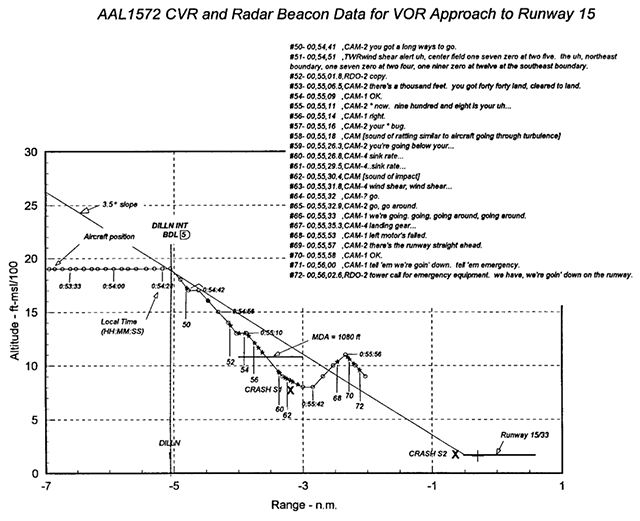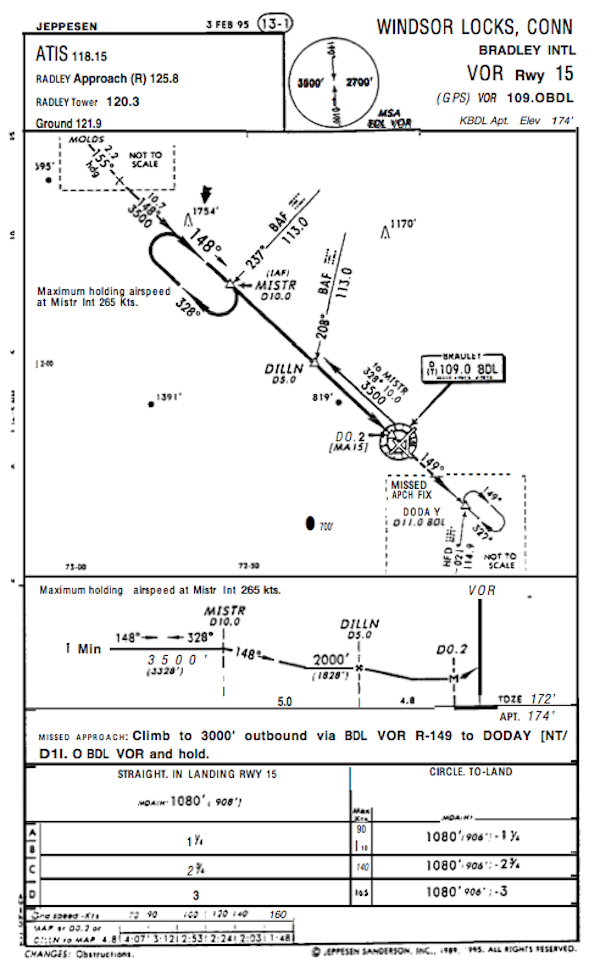This crew "dipped below" their minimum descent altitude by at least 300 feet and hit trees which damaged their engines and may have hurt their go around capability. It was turbulent, to be sure. They were using standard, for back then, "dive and drive" techniques. It appears the captain forgot to level off at the MDA, the first officer caught this, and the captain reacted by pressing the altitude hold button. The aircraft started to decrease its descent rate but struck the first set of trees four seconds later.
— James Albright

Updated:
2014-05-07
I often examine these mishaps with a look at what corrective action is taken to understand what really happened in the first place. From an American Airlines bulletin distributed to its DC-9 pilots on January 19, 1996:
- Despite its name a non-precision approach must be executed with exacting precision.
- MDAs and step-down altitudes are limits. Any altitude level-off variation must be above the MDA or step-down altitude rather than below [italics in original bulletin].
- The primary attention of both pilots will be directed to the level-off at the step-down altitude or MDA.
- After level-off at the MDA, the pilot-not-flying will direct primary attention outside the airplane and callout visual references in the sequence required.
Growing up in the "We eat our young" flight evaluation world, we always treated the MDA has a concrete floor, looking for even an inch of deviation before saying "I've got it." But there is a better way. Why not just stop using the MDA completely? More about this: Continuous Descent Final Approach (CDFA).

1
Accident report
- Date: 12 November 1995
- Time: 00:55 EST
- Type: McDonnell Douglas MD-83
- Operator: American Airlines
- Registration: N566AA
- Fatalities: 0 of 5 crew, 0 of 78 passengers
- Aircraft Fate: Substantially damaged, repaired
- Phase: Approach
- Airports: (Departure) Chicago-O'Hare International Airport, IL (ORD / KRD), United States; (Destination) Windsor Locks-Bradley International Airport, CT (BDL / KBDL), United States
2
Narrative
On November 12, 1995, at 0055 eastern standard time a McDonnell Douglas MD-83, N566AA, owned by American Airlines and operated as flight 1572, was substantially damaged when it impacted trees in East Granby, Connecticut, while on approach to runway 15 at Bradley International Airport (BDL), Windsor Locks, Connecticut. The airplane also impacted an instrument landing system antenna as it landed short of the runway on grassy, even terrain. Flight 1572 was being conducted under Title 14 Code of Federal Regulations, Part 121, as a scheduled passenger flight from Chicago, Illinois, to Bradley International Airport.
Source: NTSB Aircraft Accident Report, AAR-96/05, pg. vi.
- The airspeed started to decrease, and the airplane began a slow descent. The rain stopped, and the first officer saw the runway. According to the captain, the right engine was not sustaining full thrust, and, at 0056, he said, "Tell 'em we're goin down." The first officer complied. The first officer then stated to the captain, "you're going to make it," and queried whether the captain wanted the landing gear lowered. The first officer then selected the landing gear to the "down" position.
- The captain stated that he then called for flaps to be lowered to 40 degrees to achieve a "balloon effect" to reach the runway. The airplane clipped the top of a tree near the end of the runway, impacted and destroyed most of the ILS antenna array located at the end of the safety overrun area for runway 33, and landed on the edge of the stopway. The airplane rolled down the stopway and continued down runway 15, stopping on the runway beyond the intersection of runway 6/24 near the tower.
Source: NTSB Aircraft Accident Report, AAR-96/05, pg. 6.
3
Analysis
We'll take up the approach just as the autopilot captures the final approach fix altitude:
The autopilot captured the airplane's altitude at 2,000 feet, prior to their arrival at the final approach fix, named DILLN, which was 5 DME from the VOR. After passing DILLN, the captain told the first officer to set the missed approach altitude of 3,000 feet in the flight guidance control panel 9 (FGCP). He began the descent to the minimum descent altitude (MDA) of 908 feet above the field elevation, using the VERT SPD mode of the autopilot. At 0054:22, the captain asked the first officer to "give me a thousand down."
Source: NTSB Aircraft Accident Report, AAR-96/05, pg. 6.
American Airlines, at the time of the accident, was the only U.S. airline that used QFE for takeoff, departure, approach, and landing. That is why they used a MDA of 908 feet. (908 + 172 = 1,080) I hear they went to the U.S. industry standard QNH sometime after this mishap.
- Although the tower was temporarily closed at this time, a TRACON supervisor was in the tower cab and communicated with the flightcrew. (See Section 1.18.1.1 for details.) At 0054:51, the TRACON supervisor in the tower issued a windshear alert giving winds for the centerfield, northeast boundary, and southeast boundary of the airport. At 0055:06, the first officer stated, "there's a thousand feet...cleared to land." At 0055:11, he further stated, "...now nine hundred and eight is your uh..." The captain replied, "right."
- The first officer later told investigators that he had ground contact "straight down" and, as the airplane was "at the base of the clouds," he began looking for the field visually. He then looked back at his altimeter and saw that the airplane was descending below the MDA. Following a short period of flying through turbulence, at 0055:26.3, the first officer stated "you're going below your...." According to the captain's interview and the flight data recorder, at this point the captain pushed the altitude hold button for the autopilot.
- According to the CVR, the "sink rate" warning was heard approximately four seconds prior to the first impact with trees. At 0055:30.4, the CVR recorded a sound of impact. The captain later stated that he then heard a "loud report," followed by severe turbulence. According to the first officer, the captain called for a go-around and "firewalled the throttles." Flaps were selected to 15 degrees, and the landing gear handle was placed in the "up" position. Both flight crewmembers reported that the on-board windshear warning system and the ground proximity warning system (GPWS) activated after the impact, which was confirmed by the CVR recording. The captain stated that in a "second or two," the turbulence stopped, and, at 0055, according to the CVR recording, he said to the first officer "Left motor's failed."
Source: NTSB Aircraft Accident Report, AAR-96/05, pg. 6.
Investigators found both engines had ingested parts of trees and the left engine compressor stages were damaged by impact from the stators.
4
Cause
The National Transportation Safety Board determines that the probable cause of this accident was the flightcrew's failure to maintain the required minimum descent altitude until the required visual references identifiable with the runway were in sight. Contributing factors were the failure of the BDL approach controller to furnish the flightcrew with a current altimeter setting, and the flightcrew's failure to ask for a more current setting.
Source: NTSB Aircraft Accident Report, AAR-96/05, pg. vi.
In summary, regardless of the outdated altimeter setting that affected the indicated altitude that the flightcrew observed, they allowed the airplane to descend about 309 feet below the indicated MDA for the instrument approach. The captain initially did not recognize the descent below MDA, and he failed to react immediately when he was alerted to the altitude deviation by the first officer. The Safety Board concludes that the flightcrew's failure to maintain the required MDA until the required visual references identified with the runway were in sight directly caused this accident.
Source: NTSB Aircraft Accident Report, AAR-96/05, pg. 67.
References
(Source material)
NTSB Aircraft Accident Report, AAR-96/05, Collision with Trees on Final Approach, American Airlines Flight 1572, McDonnell Douglas MD-83, N566AA, East Granby, Connecticut, November 12, 1995

